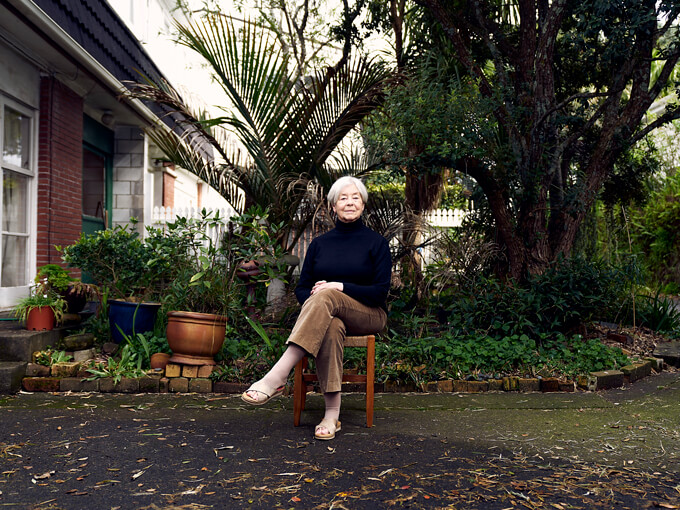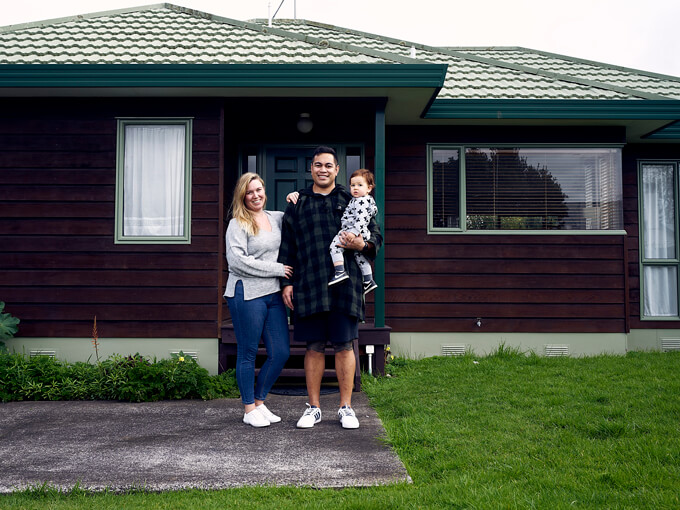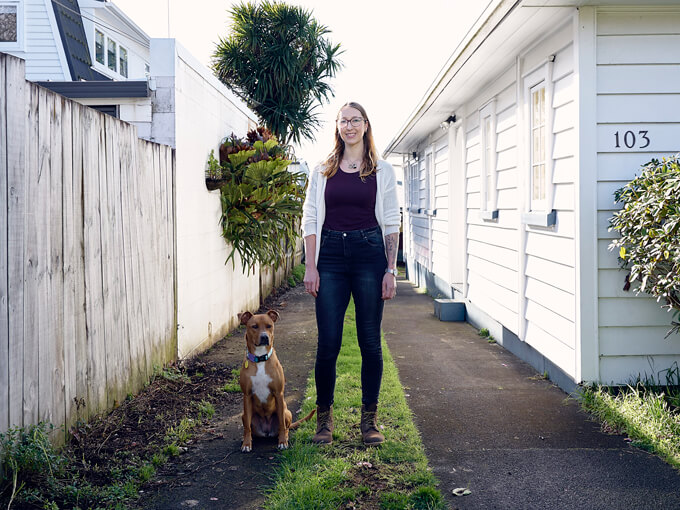Oct 31, 2019 Property
Auckland house prices have fallen a little in the past couple of years, but from great heights. The ranks of Generation Rent continue to swell as the causes of our housing crisis remain. Metro provides an update.
There’s no denying it — houses have become even less affordable. Over the past five years, New Zealand house prices increased by 45%. Rents rose by 26%. Average weekly earnings increased by just 15%.
When my wife and fellow economist, Selena, and I wrote Generation Rent nearly five years ago, many still denied there was a housing crisis. Now, there is a broad consensus and the disagreements are about what must be done to fix it. Admitting there’s a problem is the first step to recovery.
The housing crisis has been many decades in the making. The reasons home ownership in New Zealand has been sliding since 1991 are many and varied: we don’t have enough homes and most of the ones we do have are expensive and not very good quality; land supply is slow; finance is more readily available for existing houses than building new homes; funding for infrastructure is limited; social housing is underfunded; construction sector productivity is poor; the Building Code is decades behind places like Canada; and renting is still a precarious housing option as there aren’t enough rental properties and landlording is still largely a cottage industry.
READ MORE: Capital gains tax, another winnable fight needlessly lost by the left
So it’s easy to be gloomy. But many recent policy initiatives are heading in the right direction. They will take time, and more needs to be done for better housing outcomes. Rental reforms and increases in state housing supply are positive but both could go further. Longer-term reforms of land and infrastructure supply are critical, but still being worked through. KiwiBuild, to date, has been a dud, but a pivot to build-to-rent, shared equity and long-term agreements to boost the construction sector could reverse fortunes. Banking reforms could make it harder for developers and first-home buyers to borrow.
Landed gentry
Owning your own home remains a quintessential Kiwi dream, but it has been increasingly out of reach for most New Zealanders. More people are renting for longer, and may never own. And those who just get onto the property ladder are slaves to their mortgages, taking a big chunk of their income in servicing their debt for much of their working life. More people are retiring with mortgages.
But those who are already in property, and have been for a long time, are sitting pretty. They will retire relatively comfortably, and some are cashing up and retiring in the provinces. Their kids are using the bank of mum and dad to buy, or will inherit. Those who can’t give money are helping by letting their adult kids move back home to save a deposit. Parents naturally want to do the best for their kids, so the path to home ownership is increasingly tied to your heredity. But that runs counter to New Zealand’s egalitarian self-image. The landed gentry are already here and will not be dislodged for some time.

Making renting better
There are attempts to make renting better. Updating of the Residential Tenancies Act, which was passed in 1986, is the first step to making renting better. When the act was first put in place, home ownership was still within grasp and there was provision of social housing. So renting was seen more like flatting — something most did only while they were young, before buying property. But times have changed. More people are renting across many life stages and many will continue to rent through to retirement.
The two biggest issues with the rise of renting are around uncertainty of tenure and cost of rent. Both can change quickly, making renting a precarious and volatile experience. Any new policy will try to find a better balance of tenants’ rights and responsibilities. Among wealthy countries, New Zealand is unusual in how lax our tenancy rules are and how biased they are against tenants.
While New Zealand has extensive industrial health and safety rules, the rental sector is somehow largely exempt. It is perfectly legal to rent out homes that are cold, damp, mouldy and make people sick. The Government’s new Healthy Homes Standards focus on the quality of rental properties. This is long overdue.
The new policy aims to help insulate and heat homes. But it is not clear if our housing stock will be improved enough through this policy, which still allows single-glazed windows and no insulation in walls. Adding a heating source is a good idea, but it may be unaffordable for many to heat a home.
The new standards are helpful. There will need to be ongoing monitoring to make sure they are in fact making renting more secure and comfortable. We should watch the experiences of places like Ireland and Scotland, who are moving from a system more like ours towards German and Swiss models, where renting is the norm.
A big missing ingredient is a way to build more rental homes, as they do in the United States (multifamily homes) and Europe (build to rent). We need to build more rental homes that are owned and managed professionally. There are efforts to do this, like the build-to-rent scheme in Hobsonville by the NZ Super Fund, Ngai Tahu and New Ground Capital. To really scale up, there needs to be some way to kickstart the sector — which may be an opportunity for the failing KiwiBuild.
There are increasing signs of rental shortages in many parts of the country. While average weekly wages have increased by 15% in the past five years, rents have increased nationwide by around 25%. They have increased by more than 30% in Northland, Waikato, Bay of Plenty, Hawkes Bay, Wellington and Otago.
This is partly because very little of the new housing tends to be for rentals. So, unless we build more rental homes first, we won’t improve the lot of current renters who can’t get a break. Policies aimed at boosting homeownership will have to come much later.
The most vulnerable people in all this uncertainty are the poor and working class, who are caught in a vicious squeeze as the previously middle class are now renting and crowding them out. Housing New Zealand is building more homes and is set to continue for many years to come. This is much needed, as the number of state houses had been trending down since a peak in 1991 and exacerbated by recent state house sales. But the planned increase of 6400 state houses over four years is only around half of the current waiting list of more than 12,000.
We are planning to fail. The state housing programme needs to be much bigger. Most tenants have multiple and complex needs, not just for housing. Giving them a secure home is a good start to breaking the poverty trap and providing other necessary services.

Building more
Our biggest problem in New Zealand is that we don’t build enough homes, especially modest dwellings and social and rental housing.
It is true that fast population growth exacerbates matters. When net migration (both from overseas and other regions) is high, demand for houses rises faster than we can build them. But history also shows that we can’t build enough even when population growth slows. It is tempting to manage population growth, and we may want to for other reasons, including smoothing out peaks in demand, but it won’t solve our inability to build enough houses. We have long known there are challenges with planning rules, infrastructure funding and construction-sector capacity to build more homes. Some of these are changing.
There are slow-moving but important changes under way in how local authorities plan, and new tools to fund infrastructure for housing. The last National-led government attempted to do this with the Housing Accords and Special Housing Areas Act in 2013. It set, but failed to reach, a target of 39,000 homes in three years in Auckland. Auckland has never consented that many homes in a three-year period.
This was followed by the National Policy Statement on Urban Development Capacity. It sounds dry but has been a big piece of work inside government to better understand where and how to manage urban growth within the Resource Management Act (RMA).
Every government vows to reform the RMA, but none have succeeded yet. Making it work better is a good compromise. The new Ministry of Housing and Urban Development takes housing issues out of the MBIE (Ministry of Business, Innovation and Employment) behemoth. It may give greater focus and accountability.
The new Kainga Ora — Homes and Communities agency will have the power to set aside local objections, although the main aim is to speed up supply by co-ordinating big urban development and regeneration projects.
A pilot project funded infrastructure with targeted rates on new homes, so the user pays, rather than upfront development contributions and contributions from existing ratepayers. The pilot has gone smoothly so far and may expand. This reduces upfront land and home costs, and will enable councils to fund more infrastructure.
All these changes recognise the issues with land and infrastructure supply. These policies are welcome, but will need careful evaluation, because we simply don’t know how well they will work out yet.
In a way, the Auckland Unitary Plan led the way with a significant increase in housing supply, going up and out. And it’s starting to work — there are more medium-density houses, especially terraces and low-rise apartments, coming through, but the council is cash strapped to fund the infrastructure needed to really unleash more residential construction. The new policy moves will help.
We can unlock land and funding, but building houses remains fraught, both in terms of capacity and quality. The construction sector is bursting at the seams. Consents are at record highs, but the industry can barely cope, with anecdotes about slowing house sales freezing spec builders. Labour shortages are rife and financial troubles are spreading.
The bigger problem is that the construction sector’s productivity has barely improved in decades. Standardisation of design and products, and prefabrication — common internationally — remain in their infancy here. Our Building Code and systems of product certification are old and out of sync with the rest of the world, meaning we can’t tap into global labour markets, materials supply chains and building innovation trends. There is also lingering risk aversion to new ways of doing things following the leaky-building crisis; especially wary are councils, who in practice are left facing major claims under joint and several liability. The current system is hindering innovation. We have to make better use of insurance, licensed professionals, and of building envelope professionals as they do in Canada post their own leak crisis.
Public building programme
The Labour-led Government’s flagship KiwiBuild policy to build 100,000 homes in a decade has fizzled. But the policy need not be a failure, if it models itself on the New Zealand housing experience of the 1950-70s and Sweden’s million homes programme in the 1970s. Both took a co-ordinated long-term approach to create certainty for developers, standardised designs and, in Sweden, prefabricated housing.
In reality, 100,000 homes for ownership are simply too many; the people they want to help can’t afford to buy. KiwiBuild will need to be recast to build social houses, build-to-rent, and assisted ownership, with some daring experiments like long-term land leases (with rights of conversion to freehold).
READ MORE: Are rising house prices changing the spirit of Onehunga?
Infected by Sydney price falls?
Over the past couple of years, house prices fell in Sydney and Melbourne, particularly for apartments. This is because of an unprecedented house and apartment building boom in the past five years. Their housing markets went from under-supply to over-supply in some segments. A crack-down on the banking sector also cut off funding for risky borrowers.
In New Zealand, we had a big construction slump a decade ago and it took a long time to recover. Consents are now running at record highs, but we have to keep going at this pace for perhaps a decade before we have enough homes, let alone too many. The risks of prolonged price falls seem unlikely.

Banking reform uncertainty
The banking sector is facing a regulatory sea change here and in Australia. It could slow house building and, surprisingly, house prices. From the mid-1980s, easier access to credit played a big part in letting house prices increase. Banks and regulators allowed deposits to shrink and mortgage terms to lengthen, which took a greater portion of buyers’ incomes in mortgage payments. All of this meant that for any given income, it was possible to borrow more and pay a higher price.
But banking reform is in the air both here and in Australia. It looks very likely that banks will be made less risky, by holding more of their own money. This is likely to see banks lend less, lend less riskily, or charge more. Maybe all of the above. This could slow lending to house building, which is generally considered risky because of the boom-bust cycles.
Other changes currently under way could also see more regulatory oversight on how much banks lend, and to whom. We already have loan-to-value ratios. In the UK, they also have loan-to-income ratios, limiting how large a loan can be relative to income. Debt-servicing ratios can also limit how much a person’s repayments can drain their income. This could reduce house prices over time, as the size of mortgages relative to incomes would be smaller.
Urgency and creativity
In Generation Rent, we proposed 10 solutions to be implemented in a package. There has been progress in some areas, others will take much longer, and some are neglected. Improvements in rental policy and increases in social housing are already under way. They are welcome and need to go further.
Big policy work on land-use planning and infrastructure will take time, as such large complex policies should. Long term, this will have the biggest impact. For now, affordable and plentiful homes are still far away.
I am convinced we need to act now to look after those worst affected by the housing crisis. To do that, we have to massively increase social housing, well beyond the current projections. But it would still be a small part of the solution. The game changer is the build-to-rent sector. This will have the most immediate impact on improving housing outcomes.
We need creative ideas to funnel patient capital to do this and innovation in government procurement. For example, a tax-free inflation-linked bond available only to KiwiSaver investors could fund build-to-rent homes. These homes could be reserved for only those eligible for the Accommodation Supplement (a large and growing housing subsidy) and social houses (which receive market rent). The Ministry of Social Development could guarantee payments for, say, 10 years, rising at the rate of inflation. This would give the investors secure inflation-linked income and MSD would end up paying less, as rents typically rise faster than inflation and may have less turnover.
Five years on
Has anything changed in housing since we wrote Generation Rent five years ago?
For the most part, the lived experience has not. On the political and policy sides, we have made massive strides. Across the political spectrum, there is consensus on the problem, if not the prescribed solutions.
The changes in policies are heading in the right direction. The results will take many years. We need to inject some serious creativity and urgency to get there sooner.
This piece originally appeared in the September-October 2019 issue of Metro magazine, with the headline “Generation Rent revisited”.






